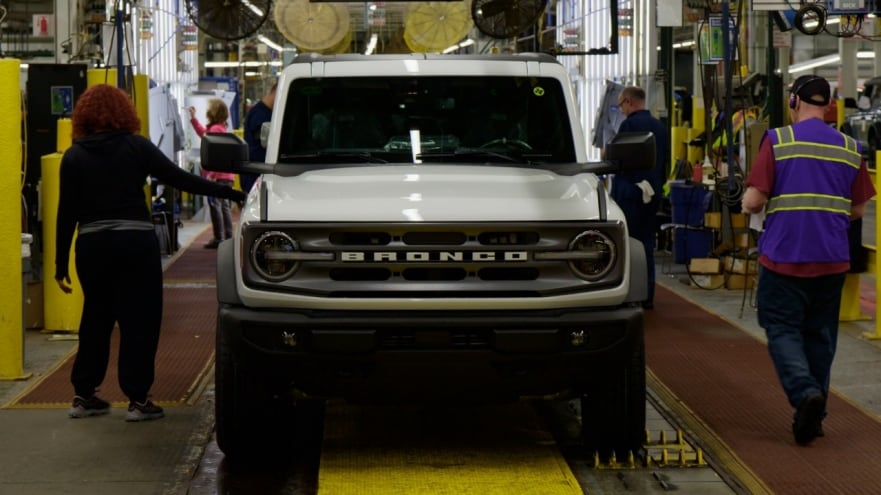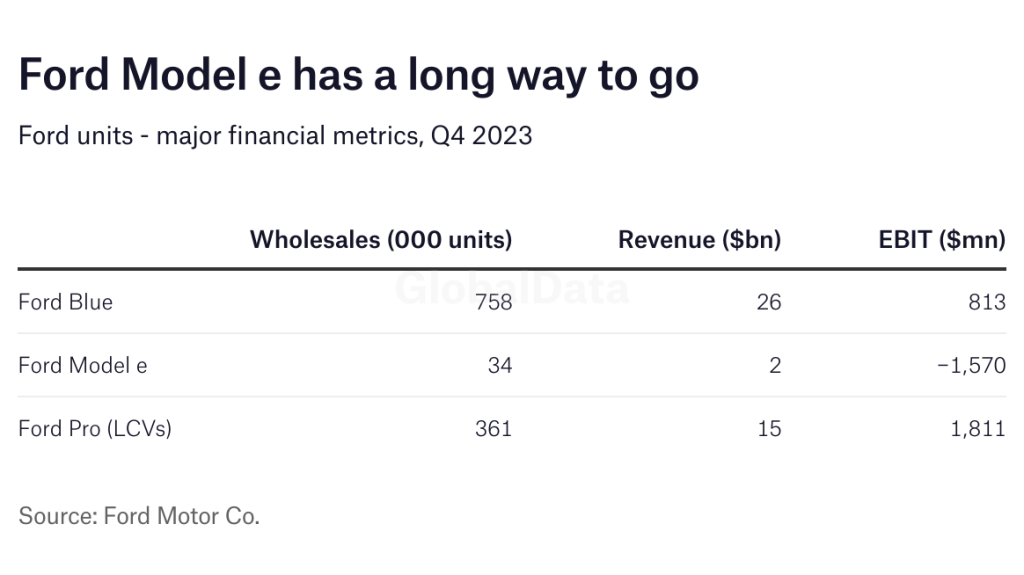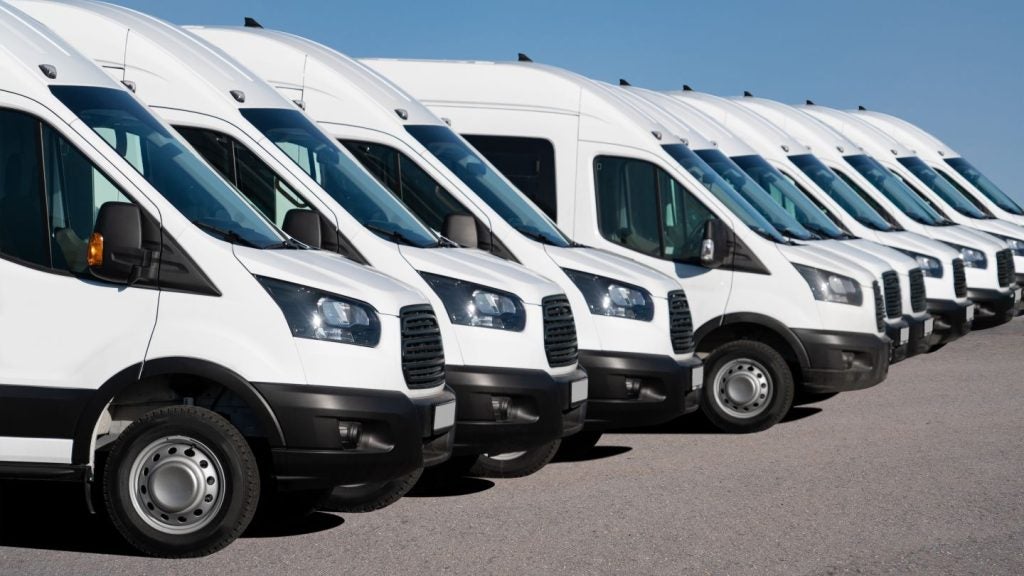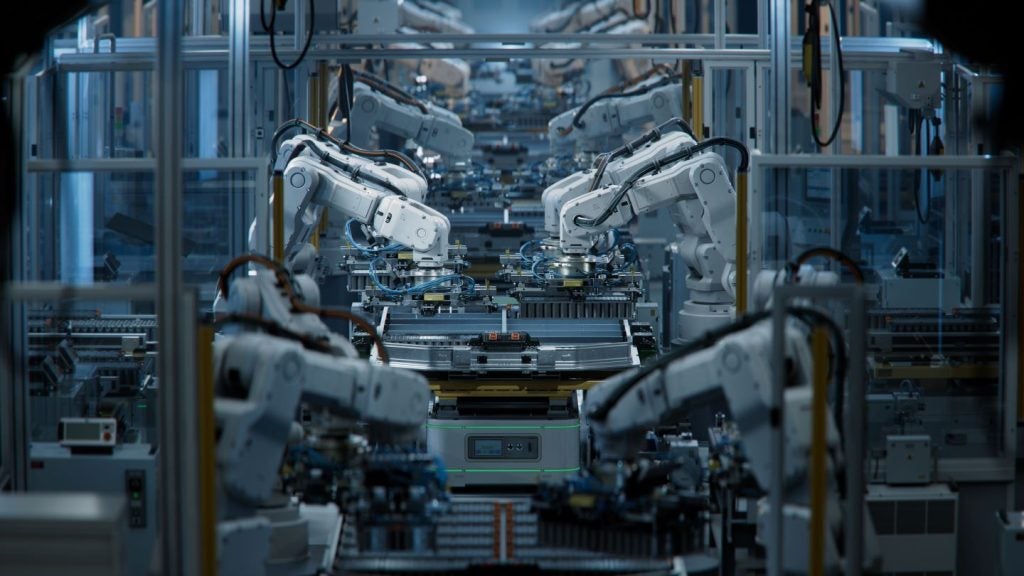
Ford posted a loss of $526 million in the fourth quarter of 2023 on increased revenue of $46 billion because of one-off items (related to the remeasurement of pension and other post-retirement employee benefits plans).
Its electric vehicle operations stayed firmly in negative territory, as expected.
Ford said Q4 adjusted earnings before interest and taxes, or EBIT, totalled $1.1 billion (compared with $2.6 billion in Q4 2022).
However, for the full year 2023, the Dearborn automaker recorded $4.3 billion in net income, a 2.5% margin, on $176.2 billion in revenue, up 11.4% year over year and surpassing expectations. Its electric vehicle operations stayed firmly in negative territory, as expected.
In the fourth quarter, Ford’s EV business unit, Model E, posted an EBIT loss of $1,570 million. By contrast, Ford Blue, the company’s ICE unit earned $813 million EBIT in the fourth quarter. Ford Pro – mainly light commercial vehicles (LCVs) – was a major profit centre for Ford in Q4, with $1.8bn in EBIT.

“We are nowhere near our earnings potential,” Ford Chief Executive Officer Jim Farley told analysts on a conference call. Ford is stressing its wide offerings of powertrains to meet variability in market demand and maximise investment returns. Recently it has adjusted operations to accommodate lower demand for EVs, including a trimming of output of the F-150 Lightning electric pickup.
How well do you really know your competitors?
Access the most comprehensive Company Profiles on the market, powered by GlobalData. Save hours of research. Gain competitive edge.

Thank you!
Your download email will arrive shortly
Not ready to buy yet? Download a free sample
We are confident about the unique quality of our Company Profiles. However, we want you to make the most beneficial decision for your business, so we offer a free sample that you can download by submitting the below form
By GlobalDataAutomakers are grappling with the transition from ICEs to electric vehicles, which come with higher costs than ICE vehicles. While the industry consensus is that the long-term outlook for BEVs remains highly positive, calibrating BEV output profitably on the pathway to higher volumes at this stage in the transition is seen by analysts as more problematic.
“EVs are here to stay, customer adoption is growing, and their long-term upside is central to Ford,” said Ford CFO John Lawler. “The customer insights we’re getting by being an early mover in electric pickups, SUVs and commercial vehicles are invaluable – especially as we’re developing next-generation EVs that are going to surprise customers and be profitable within a year of launch.”
However, with mainstream customer adoption of EVs happening at a slower rate than the industry expected, Ford said months ago that it’s deferring certain capital investments in EVs until they’re justified by demand and prospects for acceptable returns.
“Right now, the volumes just aren’t high enough to drive unit costs lower and that’s a general headwind across the industry as it faces the energy transition ahead,” GlobalData analyst Jeff Schuster told Just Auto.
“In the US, incentives are up and there’s downward pressure on still-high transaction prices that automakers have to work through. After the supply shortages of recent years, 2024 is shaping up as a return to something more like a ‘normalisation’ in North America with industry volumes shaped by demand trends rather than short supply.
“Pressures on earnings will also continue to be felt in China as the price war rips for a while longer.”
Ford also said it continued to build momentum behind its software-enabled services. Total paid software subscriptions across all segments rose 8% sequentially in the fourth quarter to about 630,000.
Outlook
Ford Chief Operating Officer Kumar Galhotra said that the company entered 2024 with the talent and structure needed to correct quality and cost issues, contributing to growing fundamental strength and upside.
“We’re seeing green shoots of quality improvement, including in our new-product launches – with several important ones coming up this year,” Galhotra said. “Across our global industrial system, we’ve identified and will land $2 billion in cost reductions, in areas like material, freight and manufacturing – and we’re just getting started.”
Ford anticipates full-year adjusted EBIT of $10 billion to $12 billion. The Ford guidance assumes flat to modestly higher full-year US industry volume, with overall lower vehicle pricing. Upsides include beneficial pricing of sales of the all-new Super Duty that Ford Pro, introduced in 2023.
The company says its total costs are expected to be flat year-over-year, the net of factors including the $2 billion in industrial cost improvements, offset by higher expenses for labour and major product-refresh actions.
At a segment level, the outlook is for full-year 2024 EBIT of at least $8 billion to $9 billion from Ford Pro and about $7 billion to $7.5 billion from Ford Blue; an EBIT loss of $5.0 billion to $5.5 billion for Ford Model e; and earnings before taxes of about $1.5 billion from Ford Credit.







